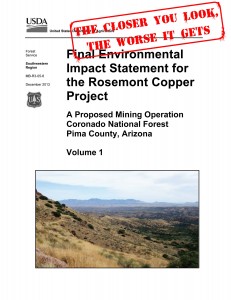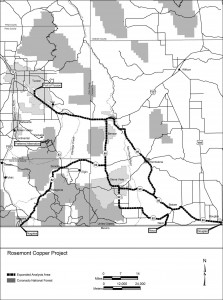This is the first in a series examining the significant failures in the Final Environmental Impact Statement (FEIS) for the proposed Rosemont Copper Mine and the serious damage that the mine would inflict on Southern Arizona’s water supplies, wildlife, mountains and economy.
In a major revision to its transportation plan, Rosemont Copper Company is now considering sending approximately 100 heavy trucks a day through rural, southern Arizona communities including Patagonia, Sonoita, Bisbee, Douglas, Naco, Sierra Vista and Nogales, according to the Final Environmental Impact Statement for its proposed open pit copper mine. (Vol. 3, Page 922-923)
Given that this new transportation plan was not spelled out in the draft Environmental Impact Statement (DEIS), the residents of these communities and those living along four state two-lane highways were not given the opportunity to comment on it. The proposed routing of heavy trucks would be used to move copper concentrate from the mine site to Mexico, where it will be sent to smelters or shipped overseas.
This issue was raised in a comprehensive objections package filed last Friday with the Regional Forester in Albuquerque, NM. The Forest Service must respond to this and all other objections filed.
Rosemont Copper is owned by Vancouver, B.C.-based Augusta Resource Corporation. Augusta is seeking state and federal permits to construct a mile-wide, half-mile deep open pit copper mine on the northeastern flank of the Santa Rita Mountains on the Coronado National Forest about 35 miles southeast of downtown Tucson.
Previously, Rosemont had stated it planned to have trucks travel north on State Route 83 beginning at mile post 47 to Interstate 10 and then west on I-10 to a railway yard at the Port of Tucson north of the intersection of Kolb Road and I-10. Rosemont said the copper concentrate would be offloaded from trucks to railcars and then shipped south through the border city of Nogales, AZ and into Mexico.
Public comments for the Draft Environmental Impact Statement released in 2012 focused on that plan.
But according to the FEIS released by the Coronado National Forest in December, Rosemont is now considering several other shipping routes including:
- SR 83 south to Sonoita and then west from Sonoita through Patagonia and into Nogales;
- SR 83 south to Sonoita and then east on SR 82 to SR 90 and then south to Sierra Vista where potential routes split: One route would continue south on SR 92 to the border crossing at Naco, Az; The other route would head east out of Sierra Vista on SR90 and then southeast on SR 80 through Bisbee to the border crossing at Douglas.
- SR 83 north to I-10 and then east to Benson. In Benson, the route would head south on SR 90 towards Sierra Vista; or south on SR 80 towards Bisbee and on to Douglas.
The FEIS suggests that the alternative transportation routes may be under consideration because the rail yard at the privately operated Port of Tucson doesn’t have the equipment needed to handle the copper concentrate.
“Construction at the Port of Tucson may be desired or required to transfer and export mine products via train, but there is no current estimate of where, when, or what work would be required,” the FEIS states.
The Port of Tucson is approximately 20 miles northwest of the mine site. The port is anticipated to receive large equipment shipments for construction and operation of the mine, according to the FEIS.
Rosemont stated in a 2012 feasibility study filed with Canadian regulators that copper “concentrates produced at the Rosemont mine will initially be shipped by truck direct to smelters within a 200-mile radius or to a railhead in the vicinity of Tucson, AZ. There it will be transferred into railcars for furtherance to more distant North American smelters or to the ports in Mexico for ocean transport to offshore smelters.”
There are only two operating copper smelters within a 200-mile radius of the proposed mine site, both owned by Grupo Mexico. The Hayden smelter operated by Grupo Mexico’s U.S. subsidiary ASARCO, is located about 70 miles northeast of Tucson. The smelter processes copper from the Ray Mine.
Grupo Mexico also operates the La Caridad smelter to process copper from the Cananea Copper Mine in northern Sonora, Mexico. Cananea is 55 miles southwest of Douglas, AZ via Mexican Route 2 and 98 miles southeast of Nogales, AZ via Mexico Routes 15 and 2. Both distances are calculated by highway travel.
It appears, however, unlikely that Rosemont concentrates will be processed at either of the smelters. Augusta’s regulatory filings state that once the copper concentrate reaches Mexico, the company intends to send it south to the Mexican port of Topolobampo, in Sinaloa.
Last August, Augusta’s wholly-owned subsidiary, Cobre Verde de Mexico, S.A. de C.V. was awarded a 25-year concession by the Administraciόn Portuaria Integral de Topolobampo, S.A. de C.V. (“API”) to build and operate a copper concentrate export facility at the Port of Topolobampo.
Augusta said it is evaluating the use of the terminal for the export of copper concentrates and has hired National Bank Financial Inc. in connection with a potential transaction involving a direct or indirect investment by third parties in Cobre Verde. Augusta states the 54,500-square meters facility will manage bulk concentrate receiving, storage, and reclaim for load-out onto transport ships.
According to Rosemont Copper’s 2012 Feasibility Study the company has 50 percent of its copper concentrate production under contract. London-based RK Mine Finance, which has loaned Rosemont up to $109 million, would purchase 20 percent of the copper concentrate up to a maximum of 1.5 million metric tons.
Rosemont’s joint venture partner, Korea-based United Copper & Moly, has agreed to purchase 30 percent of the copper concentrate production. That copper would presumably be exported to Korea.
Rosemont stated in the July 2012 feasibility study that it “is in active negotiations with several major international smelters in Asia and Europe for the sale of the remaining uncommitted production, and expects to conclude a sales contracts with one of these counterparties.”



THIS DILEMMA REPRESENTS ONE OF THE MANY UNANSWERED AND UNRESOLVED ISSUES THAT THE ROSEMONT PROJECT HAS RAISED . I AM FAMILIAR WITH THE ROAD NETWORK THAT ROSEMONT/AUGUSTA HAS PROPOSED . THIS NETWORK WAS NOT BUILT NOR DESIGNED FOR THE HAULAGE OF COPPER CONCENTRATE FROM THE PROPOSED ROSEMONT MINE. THE RESPONSIBLE STATE AUTHORITIES WHO ENFORCE SAFE USE OF THE STATE’S ROAD SYSTEM ARE NO WHERE TO BE SEEN IN THE EVALUATION OF THE ROSEMONT/AUGUSTA TRANSPORT PROPOSAL .
THE PROPOSED ROAD TRANSPORT OF HIGH DENSITY COPPER CONCENTRATES CONTAINING TOXIC CHEMICALS COULD RESULT IN MAJOR SPILLAGE AND COLLATERAL DAMAGE TO THE EXISTING ROADWAYS . WHO IS RESPONSIBLE FOR MAINTAINING THESE ROADWAYS AND ANY SPILLAGE THAT COULD OCCUR ?
THE CONCENTRATE BEING TRANSPORTED MUST BE CLASSIFIED AS ” HAZARDOUS ” AS IT WOULD CONTAIN CARCINOGENIC COMPONENTS . THE POSSIBILITY OF SPILLAGE ALONG THE TRANSPORT ROUTE POSES
A THREAT THAT COULD AFFECT MANY INNOCENT PEOPLE AS WELL AS LIVESTOCK .
THE PROPOSED ROADS TO BE TRAVELED BY THE ROSEMONT CONCENTRATE ARE RELATIVELY NARROW WITH VERY LITTLE SHOULDER . THE CARRIERS WILL AVOID THE SHOULDER AND HUG THE CENTRE LINE MAKING IT VERY RISKY FOR THE GENERAL TRAVELER USING THESE SAME ROUTES .
THERE IS NO REFERENCE TO THE USE OF GOVERNMENT WEIGH SCALES TO MONITOR THE VEHICLE LOADS COMING FROM THE PROPOSED ROSEMONT OPERATION .
NO CONCENTRATE MUST BE ALLOWED TO LEAVE THE ROSEMONT SITE WITHOUT A CERTIFICATE THAT GUARANTIES ” SAFE PASSAGE ” FROM THE MINE SITE TO THE ULTIMATE SMELTER OF CHOICE .